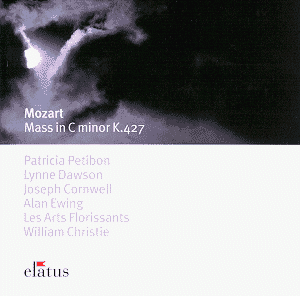Mozart
wrote no fewer than fifteen settings of the Ordinary of the Mass,
but the Mass in C minor, K427, is the only example
which dates from the last decade of his life, his years in Vienna.
Vienna was one of the major musical centres of Europe, a city
which drew Gluck to it a generation before Mozart, and which,
later, would attract Beethoven, Brahms and Mahler.
Given
that religious choral music had been the staple repertory of Mozart's
earlier career in his native Salzburg, the lack of it in Vienna
requires explanation. His circumstances as a freelance musician
in the city gave him few opportunities in this direction. Moreover
the constant feuding between the Emperor Joseph and the Jesuits,
and his own position as a committed freemason, combined to create
circumstances which only began to change in the last months of
his life, when he composed the short motet Ave Verum Corpus
and the Requiem.
The
Mass in C minor, unlike Mozart's previous settings, is
a large-scale cantata mass, the treatment of the text determined
by musical rather than liturgical priorities, in the tradition
of Haydn's St Cecilia Mass and Bach's Mass in B minor.
According to a letter from the composer to his father Leopold,
it was intended for performance in Salzburg in the summer of 1783,
when he returned home with his wife Constanze. Some evidence,
though it is by no means conclusive, suggests that a performance
took place in the Peterskirche on 25th August, with Constanze
among the soloists.
Perhaps
it was the difficulties experienced at this time that led Mozart
to abandon his Mass in an incomplete form, leaving aside
the concluding Agnus Dei movement. However, he recognised
that the music was of high quality, and made use of most of the
material in 1785 for an oratorio, the Davidde penitente, K469,
which he wrote in connection with supporting a pension fund for
Viennese musicians. In any case, the C minor Mass is complete
enough to stand as a major work in the repertory of choral music,
and large enough for Elatuc to issue it without supporting material
on this 50-minute long CD.
The
music of the Mass in C minor, which many critics regard
as Mozart's masterpiece in the field of religious composition,
has a largeness of scale and monumental grandeur which recalls
the great baroque choral masterpieces of Bach and Handel, works
which Mozart had come to know through his friendship with his
fellow freemason Baron Gottfried van Swieten. Swieten had served
in Berlin for many years as Austrian ambassador to Prussia, and
there he had developed an enthusiasm for baroque music which he
brought back to Vienna and shared with the members of his circle,
including both Mozart and Haydn.
If
anyone is in any doubt about these baroque connections, then listen
to the setting of the worcs ĎIn eccelsisí near the beginning of
the second movement Gloria. They sound remarkably like Handelís
Alleluia Chorus, and in due course Mozart would offer his own
edition of The Messiah, complete with an orchestra including clarinets.
Therefore the link is by no means fanciful.
With
all these stylistic links with earlier music, a performance by
Les Arts Florissants and William Christie holds a special interest.
And it does not disappoint. There is an imposing quality about
the tempi and phrasing when such an approach is required, such
as in the music of the Gratias, but there is a supple flexibility
in the following Domine Deus, with delightful solo singing from
the two sopranos, Patricia Petibon and Lynne Dawson, the latter
perhaps the pick of a team of soloists who work well together.
Christie
has studied the score carefully and shapes it with a long-term
vision of how it evolves on the large scale. Therefore tensions
are maintained, and Mozartís internal balances are experienced
in the textures and the details that emerge. If there are criticisms
they are the inevitable ones about quality of sound, when powerfully
expressive music such as this is performed by an Ďauthenticí ensemble.
Not that this is a worry, it is simply that if you seek greater
power, then a performance with larger symphonic forces might deliver
this more readily. For those wanting to test and hear, then the
Qui tollis will give as good an indication as might be required.
When
the fullest tone is needed, in moments such as this, the light
string sound may not be to all tastes. But in the context of the
whole performance, and so well recorded in such a pleasing church
acoustic, the concept works remarkably well.
Terry
Barfoot
